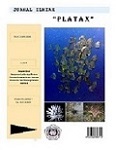Phytoplankton Density and Diversity in the Waters around the Reclamation Area in Manado Beach
DOI:
https://doi.org/10.35800/jip.1.3.2013.2568Abstract
ABSTRACT
Phytoplankton is one of the most important aquatic organisms and has a major role in the cycle of life in the waters. Phytoplankton is able to do the process of photosynthesis to produce the organic matter utilized by other organisms living in aquatic environments. Phytoplankton can also be used as one of the ecological parameters that can describe the ecological conditions of the body of water and can be used as bio-indicators of pollution in the water. The purpose of this study is to obtain the types of phytoplankton in the waters around the reclamation area in Manado Beach, to know the diversity and density of phytoplankton species, and to determine the types of phytoplankton which are dominant according to the water depth. The phytoplankton found in the research site belonged to 27 genera. Station 1, 27 species were found in 5m depth, 19 species in 15m depth and 12 species in 30m depth. Station 2, 24 species were found in 5m depth, 20 species in 15m depth and 13 species in 30m depth. For index density, station 1 and 2 at a depth of 5 m has the highest density of 11 individuals/l and 12.333 Individuals/l. Diversity indices for stations 1 and 2 showed at a depth of 5 m, 2.954 and 2.891, respectively. The dominance indices at station 1 and station 2 showed that were no species dominance.
Keywords : phytoplankton, density, diversity, reclamation area
Â
ABSTRAK
Fitoplankton merupakan salah satu organisme perairan yang sangat penting dan mempunyai peran utama dalam siklus kehidupan di perairan. Fitoplankton mampu melakukan proses fotosintesis untuk menghasilkan senyawa organik yang merupakan sumber energi yang dimanfaatkan oleh organisme lain yang hidup di lingkungan perairan. Fitoplankton juga dapat digunakan sebagai salah satu parameter ekologi yang dapat menggambarkan bagaimana kondisi ekologi suatu perairan dan dapat digunakan sebagai bio-indikator pencemaran dalam suatu perairan. Penelitian ini bertujuan untuk mendapatkan data jenis-jenis fitoplankton yang ada di perairan sekitar kawasan reklamasi Pantai Manado, mengetahui keanekaragaman dan kepadatan spesies fitoplankton dan mengetahui jenis-jenis fitoplankton yang dominan menurut kedalaman air. Jenis fitoplankton yang ditemukan di lokasi penelitian totalnya berjumlah 27 genus.  Stasiun 1, ditemukan 27 spesies di kedalaman 5m, 19 spesies di kedalaman 15m dan 12 spesies di kedalaman 30m. Stasiun 2, ditemukan 24 spesies di kedalaman 5m, 20 spesies di kedalaman 15m dan 13 spesies di kedalaman 30m.
Untuk indeks kepadatan, stasiun 1 dan 2 di kedalaman 5 m memiliki kepadatan tertinggi yaitu 11 Ind/l dan 12,333 Ind/l. Indeks keanekaragaman untuk stasiun 1 dan 2 di kedalaman 5m yaitu 2,954 dan 2,891, indeks dominasi di stasiun 1 dan stasiun 2 menunjukkan tidak adanya dominasi spesies.
Kata kunci : fitoplankton, kepadatan, keanekaragaman, kawasan reklamasi
1Bagian dari skripsi
2Mahasiswa Program Studi Manajemen Sumberdaya Perairan FPIK-UNSRAT
3Staf pengajar Fakultas Perikanan dan Ilmu Kelautan Universitas Sam Ratulangi
Downloads
Published
How to Cite
Issue
Section
License
COPYRIGHT
Authors who publish with this journal agree to the following terms:
Authors hold their copyright and grant this journal the privilege of first publication, with the work simultaneously licensed under a Creative Commons Attribution License that permits others to impart the work with an acknowledgment of the work's origin and initial publication by this journal.
Authors can enter into separate or additional contractual arrangements for the non-exclusive distribution of the journal's published version of the work (for example, post it to an institutional repository or publish it in a book), with an acknowledgment of its underlying publication in this journal.
Authors are permitted and encouraged to post their work online (for example, in institutional repositories or on their website) as it can lead to productive exchanges, as well as earlier and greater citation of the published work (See The Effect of Open Access).






































